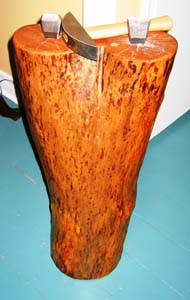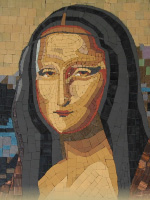Artistic Journey
Biography
I was born in Toronto, Canada, in 1955. Very young, I started to collect rocks and fossils. I became a marine biologist in 1987, after living 12 years in Marseille. A great number of frustration-liberating post-doctoral walks were an opportunity to cover significant ground in the South of France. The collector instinct kicked in once again. In a few weeks, I had gathered vast amounts of shards found in vineyards and on trails. What to do with all this? A collage! I had unknowingly penetrated the world of mosaics. In Canada since 1988, I have been pursuing a career in the environment field. I have developed my own mosaic creation technique and am constantly learning old and newer methods. The art of mosaics is an ancient one and their traces present throughout the globe are an incentive to visit them in situ. And shards can be found everywhere!
Artistic statement
I situate my work between mosaics and “Found Objects”. Compositions produced blend a classic mode of expression with material collected in urban environments or not, originating from all the countries visited on this Planet ridden with detritus and “bulging at the seams” with history. In a way, I feel that I contribute to the reduction of the human imprint on the environment by transforming trash into cultural symbols of man’s worthiness and aesthetics, although he himself may not be so “worthy”. The trashed object has a value beyond the monetary that I attempt to portray in my works.
Materials and methods
My materials of choice are ceramic shards but I also use glass, metal, plastic, paper, cut stone or marble. I search for shards myself although friends and family supply me with numerous “gifts”. I visit all empty lots that I stumble upon and search for an indication of the presence of shards (look for oyster shells!). When embarking on a mosaic creation spree, I spread out the collection of shards, kept in buckets, on the floor to compose my artist’s “palette”.

I use a direct method, and place the pieces on surfaces of wood, glass, or mirror. Occasionally, I have experimented in the fabrication of 3 dimensional works, the pieces fixed on plastic or glass (old computer and screen). I apply the adhesive on the entire surface before fixing the pieces or I fix each piece one at a time: the former when I wish to create in an “automatiste” frame of mind, the latter when I wish to conform to a predetermined motif. Usually, the adhesive is mixed with pigments for colour effects or to enhance the contrast between the background and the mosaic assemblage. I never, or rarely, use grout: I seek out coarse textures that I control by fixing the pieces, often cut with nippers, close together.
I can create tessera by nipping the shards or use the hammer and hardie with stone and marble. The raw or cut pieces are then assembled into “mosaic-collages” as Patricia Pink called them. The adhesive material can be discrete or completely fill in the openings or again overlay the pieces.
My works are pictorial, either abstract or figurative.
